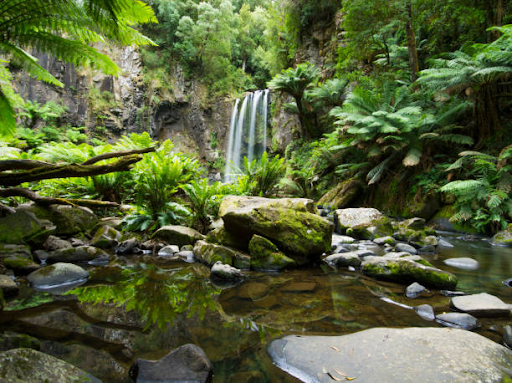Australia’s Great Ocean Road
is world-renowned for its breathtaking coastal scenery, rich history, and charming towns. This route is more than just a scenic drive; it’s a journey into some of Australia’s most iconic landscapes and attractions. If you’re planning a day trip from Melbourne or nearby, our comprehensive Great Ocean Road day tour guide will help you make the most of this incredible coastal adventure.
Planning Your Great Ocean Road Adventure
Whether you’re planning a solo road trip or a guided group tour, knowing when to go, how to travel, and what to see along the Great Ocean Road can help you make the most of your day. Here’s what you need to know before you start your journey.
When to Visit the Great Ocean Road
When planning a day tour along the Great Ocean Road, timing is key. The best time to visit is during the shoulder seasons, in spring (September to November) and autumn (March to May), when weather conditions are mild, and visitor traffic is lower. Summer (December to February) is popular, but it’s also the busiest period, with higher temperatures and more tourists. Winter (June to August) offers a quieter experience, with stunning whale-watching opportunities as southern right whales migrate along the coast.
- Best seasons: Spring and Autumn offer mild temperatures, making them ideal for exploring.
- Weather conditions: Temperatures can vary, so check the forecast and dress accordingly.
- Visitor traffic: Expect more crowds in summer, so consider an early start to avoid peak traffic on this popular route.
Essential Tips for a Smooth Journey
To enjoy a hassle-free journey, consider these travel tips for your Great Ocean Road adventure:
- Car rental options: If you’re self-driving, rental cars are available from Melbourne or nearby cities. Ensure you book in advance, especially during peak season.
- Road safety tips: The Great Ocean Road has many winding sections, so drive carefully and watch out for wildlife crossing, especially at dawn and dusk.
- Itinerary planning: With so much to see, map out your stops to ensure you hit all the must-see spots while allowing enough time for spontaneous detours.
Must-Visit Stops Along the Great Ocean Road
With scenic views around every corner, you’ll want to stop frequently along the Great Ocean Road. From iconic landmarks to hidden gems, here are some stops that should be on your itinerary.
Iconic Landmarks and Natural Wonders
One of the main draws of the Great Ocean Road is the abundance of natural attractions. Here are some of the top sights to see:
- Twelve Apostles: Perhaps the most famous attraction on the Great Ocean Road, the Twelve Apostles are towering limestone pillars rising from the ocean. Located near Port Campbell, this spot offers some of the most awe-inspiring coastal views in Australia.
- Loch Ard Gorge: Just a few minutes from the Twelve Apostles, this gorge offers a fascinating history along with scenic views. Named after a shipwreck in 1878, Loch Ard Gorge features towering cliffs, turquoise waters, and a serene beach.
- London Bridge: Once a natural archway connected to the mainland, this rock formation collapsed in 1990. Although it’s no longer a bridge, it remains a striking sight and a fantastic photo opportunity.
Hidden Gems Off the Beaten Path
While the popular landmarks are worth visiting, the Great Ocean Road is also home to lesser-known gems:
- Lesser-known beaches: Discover quieter spots like Wye River Beach or Blanket Bay, where you can relax away from the crowds.
- Waterfall hikes: Take a detour to explore some hidden waterfalls like Erskine Falls near Lorne or Hopetoun Falls in the Otways National Park. These hikes offer a refreshing break from the coastal drive and a chance to see the lush rainforest.
Activities to Enhance Your Great Ocean Road Experience
Beyond sightseeing, the Great Ocean Road offers plenty of activities to make your trip unforgettable. Whether you’re an adventurer or a nature enthusiast, there’s something for everyone.
Adventure and Outdoor Sports
If you’re looking for an adrenaline rush, there are plenty of outdoor activities along the Great Ocean Road:
- Surfing spots: The region is home to famous surfing beaches like Bells Beach near Torquay, known for its world-class waves and surf competitions.
- Hiking trails: There are numerous trails along the coast, with options for all fitness levels. For a memorable experience, try the Great Ocean Walk, which stretches 104 km from Apollo Bay to the Twelve Apostles.
- Scenic flights: To experience the Great Ocean Road from a different perspective, consider taking a scenic helicopter flight over the Twelve Apostles and Port Campbell National Park. It’s an unforgettable way to capture the full beauty of the coastline.
Local Wildlife Encounters
Australia’s unique wildlife is a highlight of any Great Ocean Road tour. Here are some ways to spot local animals in their natural habitats:
- Koala viewing: Head to Kennett River, a small town along the Great Ocean Road, known for its high population of wild koalas. You’re likely to spot them lounging in the eucalyptus trees.
- Bird watching: The region is home to diverse bird species, from colorful parrots to sea eagles. Keep an eye out for birds, especially in areas like the Otways.
- Whale watching seasons: During winter, southern right whales migrate along the coast, making it a great time for whale watching. Look for them at Warrnambool or Logan’s Beach.
Dining and Accommodation: Local Recommendations
A long day of exploring calls for delicious food and comfortable lodging. Here are some local recommendations for dining and accommodations along the Great Ocean Road.
Best Eateries Along the Great Ocean Road
From fresh seafood to cozy cafes, the Great Ocean Road offers a range of dining options:
- Seafood restaurants: For seafood lovers, Apollo Bay is a must-stop. Enjoy fresh seafood at local eateries like The Fishermen’s Co-op, known for its locally caught fish and chips.
- Local cafes: Towns like Lorne and Anglesea have plenty of charming cafes. Try Lorne’s Swing Bridge Cafe for a relaxed atmosphere and delicious breakfast options with scenic river views.
Where to Stay: Lodging Options for All Budgets
Whether you’re looking for budget-friendly or luxurious accommodations, there are options to suit all travelers:
- Campgrounds: For a more adventurous experience, consider camping at Great Otway National Park. It’s an affordable way to stay close to nature and enjoy stunning night skies.
- Luxury resorts: For those who prefer a bit more comfort, places like RACV Torquay Resort offer luxurious amenities and stunning ocean views.
- Family-friendly hotels: Families will appreciate options like the Cumberland Lorne Resort, which offers spacious rooms, a pool, and easy access to local attractions.
Conclusion
The Great Ocean Road offers a journey like no other, with endless scenic beauty and diverse activities to suit every traveler’s interests. From world-famous landmarks to hidden gems, this iconic route provides unforgettable experiences that showcase the best of Australia’s coastal landscapes.
Ready to explore the majestic Great Ocean Road? Book your guided day tour now and witness Australia’s coastal splendor firsthand. Visit our website or call today to reserve your adventure!
FAQs about Explore the Great Ocean Road
What are the top sights to see on a Great Ocean Road day tour?
The must-see attractions include the Twelve Apostles, Loch Ard Gorge, and London Bridge. Additionally, take time to explore hidden gems like lesser-known beaches and waterfall hikes.
How long does it take to drive the Great Ocean Road?
The Great Ocean Road spans approximately 243 kilometers, which can take about 4-5 hours to drive one-way without stops. For a day tour, plan for 8-10 hours to fully experience the sights along the way.
Are there guided tours available for the Great Ocean Road?
Yes, many companies offer guided tours that depart from Melbourne. These tours often include transportation, meals, and a knowledgeable guide who provides insights into the area’s history and attractions.
What should I pack for a day trip on the Great Ocean Road?
Essentials include sunscreen, a hat, water, and snacks. Don’t forget your camera to capture the stunning scenery, and consider packing layers as the weather can change quickly.






